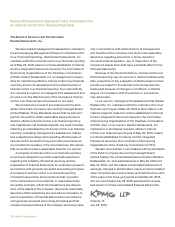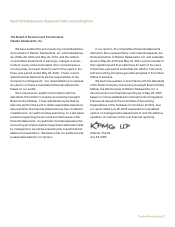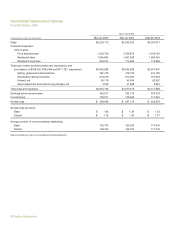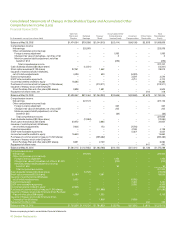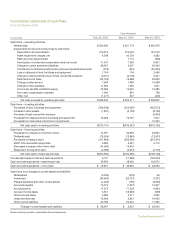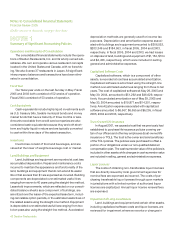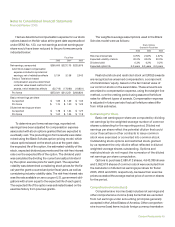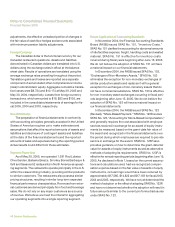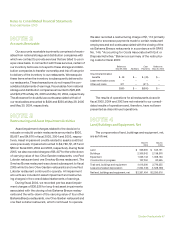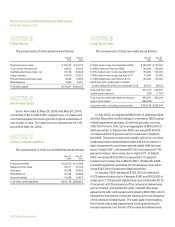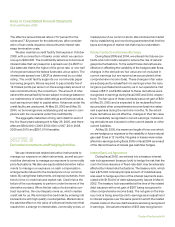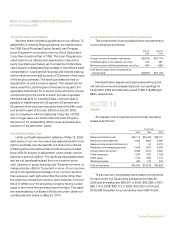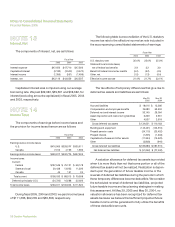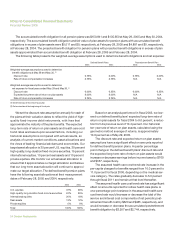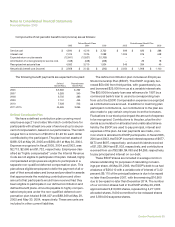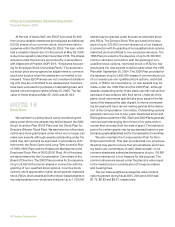Red Lobster 2005 Annual Report Download - page 38
Download and view the complete annual report
Please find page 38 of the 2005 Red Lobster annual report below. You can navigate through the pages in the report by either clicking on the pages listed below, or by using the keyword search tool below to find specific information within the annual report.Notes to Consolidated Financial Statements
Financial Review 2005
46 Darden Restaurants
adjustments, the effective unrealized portion of changes in
the fair value of cash flow hedges and amounts associated
with minimum pension liability adjustments.
Foreign Currency
The Canadian dollar is the functional currency for our
Canadian restaurant operations. Assets and liabilities
denominated in Canadian dollars are translated into U.S.
dollars using the exchange rates in effect at the balance
sheet date. Results of operations are translated using the
average exchange rates prevailing throughout the period.
Translation gains and losses are reported as a separate
component of accumulated other comprehensive income
(loss) in stockholders’ equity. Aggregate cumulative transla-
tion losses were $8,724 and $10,174 at May 29, 2005 and
May 30, 2004, respectively. Losses from foreign currency
transactions, which amounted to $18, $53 and $105, are
included in the consolidated statements of earnings for fis-
cal 2005, 2004 and 2003, respectively.
Use of Estimates
The preparation of financial statements in conformity
with accounting principles generally accepted in the United
States of America requires us to make estimates and
assumptions that affect the reported amounts of assets and
liabilities and disclosure of contingent assets and liabilities
at the date of the financial statements and the reported
amounts of sales and expenses during the reporting period.
Actual results could differ from those estimates.
Segment Reporting
As of May 29, 2005, we operated 1,381 Red Lobster,
Olive Garden, Bahama Breeze, Smokey Bones Barbeque &
Grill and Seasons 52 restaurants in North America as operat-
ing segments. The restaurants operate principally in the U.S.
within the casual dining industry, providing similar products
to similar customers. The restaurants also possess similar
pricing structures, resulting in similar long-term expected
financial performance characteristics. Revenues from exter-
nal customers are derived principally from food and beverage
sales. We do not rely on any major customers as a source
of revenue. We believe we meet the criteria for aggregating
our operating segments into a single reporting segment.
Future Application of Accounting Standards
In November 2004, the Financial Accounting Standards
Board (FASB) issued SFAS No. 151, “Inventory Costs.”
SFAS No. 151 clarifies the accounting for abnormal amounts
of idle facilities expense, freight, handling costs and wasted
material. SFAS No. 151 is effective for inventory costs
incurred during fiscal years beginning after June 15, 2005.
We do not believe the adoption of SFAS No. 151 will have
a material impact on our financial statements.
In December 2004, the FASB issued SFAS No. 153,
“Exchanges of Non-Monetary Assets.” SFAS No. 153
eliminates the exception for non-monetary exchanges of
similar productive assets and replaces it with a general
exception for exchanges of non-monetary assets that do
not have commercial substance. SFAS No. 153 is effective
for non-monetary asset exchanges occurring in fiscal peri-
ods beginning after June 15, 2005. We do not believe the
adoption of SFAS No. 153 will have a material impact on
our financial statements.
In December 2004, the FASB issued SFAS No. 123
(Revised), “Share-Based Payment.” SFAS No. 123R revises
SFAS No. 123, “Accounting for Stock-Based Compensation,”
and generally requires the cost associated with employee
services received in exchange for an award of equity instru-
ments be measured based on the grant-date fair value of
the award and recognized in the financial statements over
the period during which employees are required to provide
service in exchange for the award. SFAS No. 123R also
provides guidance on how to determine the grant-date fair
value for awards of equity instruments as well as alternative
methods of adopting its requirements. SFAS No. 123R is
effective for annual reporting periods beginning after June 15,
2005. As disclosed in Note 1, based on the current assump-
tions and calculations used, had we recognized compen-
sation expense based on the fair value of awards of equity
instruments, net earnings would have been reduced by
approximately $17,585, $14,822 and $17,159 for fiscal 2005,
2004 and 2003, respectively. We have not yet determined the
method of adoption or the effect of adopting SFAS No. 123R
and have not determined whether the adoption will result in
future amounts similar to the current pro forma disclosures
under SFAS No. 123.


